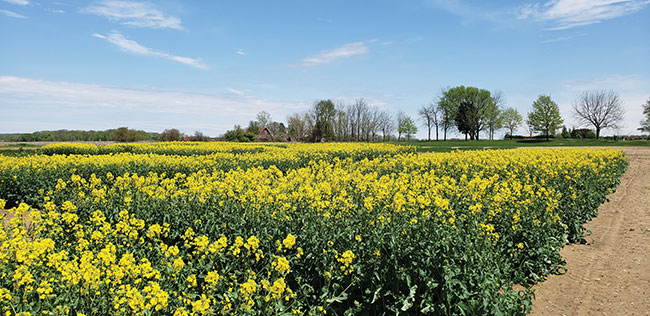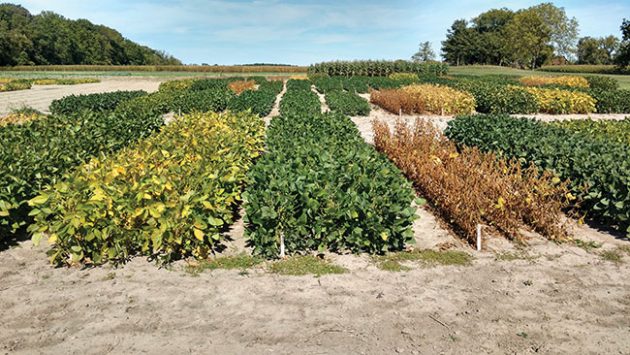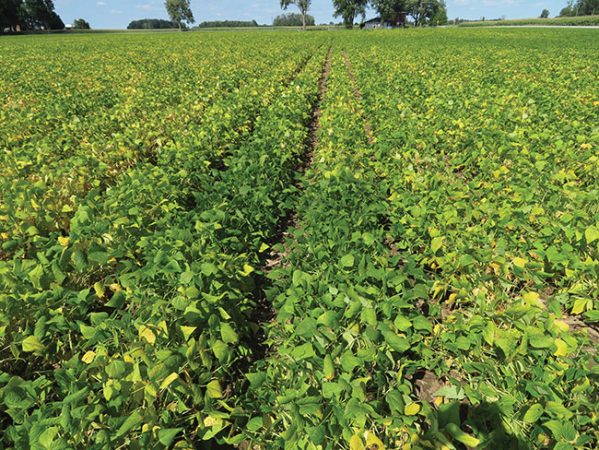
Features
Weed Management
Double-cropping synergy
Winter canola and soybean pair up for benefits in weed control, economics and more.
April 2, 2019 By Carolyn King
 Page’s winter canola plots at Harrow are getting
great yields. Photos courtesy of Sydney Meloche, AAFC.
Page’s winter canola plots at Harrow are getting
great yields. Photos courtesy of Sydney Meloche, AAFC. We have to try new and different things to move forward,” says Eric Page, a weed scientist with Agriculture and Agri-Food Canada (AAFC) in Harrow, Ont. And that’s what he is doing in his research on double cropping, the practice of growing a fall-seeded crop followed by a late-seeded summer crop. This strategy could offer a way to effectively control troublesome weeds and reduce selection pressure for herbicide-resistant weeds, while allowing the grower to harvest two crops in one season.
One of the most intriguing options he is investigating is a winter canola-soybean double crop.
Page’s interest in this pairing comes from the experience of soybean production in southwestern Ontario. “Down here in Essex, Kent and Lambton counties, we have the unhappy distinction of having four glyphosate-resistant weeds. We’ve got Canada fleabane, giant ragweed, common ragweed and now waterhemp. That makes growing soybeans here a challenge.”
Although there are new options on the market, such as dicamba-tolerant soybeans and 2,4-D-tolerant soybeans, Page is keenly interested in integrated strategies that include non-chemical weed control options. And he knows that a competitive winter crop can fight these glyphosate-resistant weeds in several ways.
“For Canada fleabane, which is a winter annual, the rosettes overwinter and then get a really early start in the spring. If you can’t control them with glyphosate, they become a problem. Having a competitive winter crop really helps to suppress growth and seed production in winter annuals,” he explains.
“For the two ragweeds and waterhemp, a competitive winter crop like winter canola is at its peak canopy when those weeds typically would be emerging in our late spring/early summer timing. The winter canola crop is intercepting most of the light [so it suppresses weed emergence and growth]. That acts as a really good non-chemical weed control mechanism.” And any weeds that do manage to grow in the canola stand are killed during combining, before the weed seeds mature.
Ideally with this double-cropping system, the soybean crop might only need a burndown herbicide to avoid yield penalties due to weeds. In-crop herbicide applications could be
eliminated, or at least reduced.
Agronomically and economically, winter canola is a good option for double cropping with soybean because it is a competitive, high-value crop and because it has the potential to be harvested early enough that the following soybean crop could produce reasonable yields in southwestern Ontario. Page explains, “Winter canola could be harvested from the last week of June to about the second week of July. Winter wheat here is typically harvested around the second to third week in July.”
Growing canola as a winter crop could also benefit canola production. For instance, winter canola could avoid or have fewer problems with pests like swede midge, lygus bug and cabbage seedpod weevil because the plant has passed its vulnerable growth stage by the time the insect is at the right stage to attack. Also, winter canola typically blooms in May, avoiding heat-stress damage to flowers and pods that can strike spring-seeded canola, especially in the southern-most parts of Ontario.
Page notes, “In terms of heat units necessary for a double crop, most of the growers who will be interested in this practice will be in our area. But I think the region where this practice would work could stretch up towards Guelph, Toronto and maybe even the Grey-Bruce area, given the right germplasm.”
Strong canola yields
To figure out whether winter canola-soybean double cropping would work agronomically, Page and his project team have been conducting trials with the two crops at Harrow. In 2016-17 and 2017-18, they compared several winter canola hybrids at five different planting dates.
In the 2016-17 trials, his team grew Mercedes, Inspiration and CC17070. In 2017-18, they added Sitro to the trials. Page had to obtain the seed for the four hybrids from an American company, Rubisco Seeds, although Mercedes, Inspiration and Sitro are originally from DL Seeds, a company based in Morden, Man. He explains obtaining seed for high-yielding, winter-hardy hybrids suited to Ontario can be a challenge: “For whatever reason, winter canola hasn’t taken off here.”
Thanks to Page’s research, Mercedes now has an interim regional registration for Ontario. Sitro is an older hybrid with national registration. Inspiration and CC17070 are not registered in Canada.
Page is very happy with the performance of these hybrids. “We are getting comparable yields to some of the best locations in the United States. For example, our yields with Mercedes are as good as or better than the best locations in the U.S. national performance trials. We have a really great climate for winter canola,” he says.
“And it’s not just my research that is getting good yields with winter canola. The Ontario Canola Growers Association [OCGA] runs a challenge every year for high-yielding canola, and the second place winner for 2018 was a producer growing Mercedes.” That producer, who is in the Woodstock area, achieved a yield of 3,705 pounds per acre.
The planting dates in the Harrow trials ranged from September 1 to mid-October. Page says, “We chose five dates that stretched across what we believed would be the permissible range and some that we knew to be outside the permissible range, to prove where the optimal date was.”
The results show the optimal planting date for winter canola in the Harrow area is mid-September. “With the right plant date, we have experienced very low overwintering stand losses between 15 and 25 per cent. But if you get the plant date wrong, you could have 50 to 70 per cent losses.” Although a late September date can produce very good yields, it is riskier than mid-September.
Page explains that August is too early for planting winter canola in the Harrow area. If planted too early, winter canola may bolt (stem elongation) before the winter. Bolted plants are very susceptible to cold temperatures so they die during the winter. “So it’s a tricky balance. You want the plants large enough to overwinter, but not too large.”
The trials used a pre-emergence herbicide to prepare the plots for canola planting. No in-crop herbicides were needed because the canola crop was very competitive. For more information on the production practices and yields in these winter canola trials, you can access Page’s reports on the OCGA website.
In the trials, the canola plots seeded in mid-September reached physiological maturity between June 20 and 28, depending on the hybrid and the year.

In this treatment, the three soybean varieties (maturity ratings, left to right, are 1.8, 3.3 and 00.8) were planted in the first week of July at Harrow and are shown here on October 2, 2017.
Good soybean yields
In 2017 and 2018, Page and his team conducted similar trials in Harrow to compare three soybean varieties at five planting dates that ranged from the last week of June to the first week of August.
They selected soybean varieties with three different relative maturities: 2510RY, rated as 00.8; 3012RY, rated as 1.8; and P33T72R, rated as 3.3. Essex County is in maturity zone III for soybean, and Kent and Lambton are in zone II. A fairly narrow row spacing of 15 inches was used so the soybeans could close their canopy faster and be more competitive with weeds. The team collected data on things like yields and weed populations.
Page is in the process of analyzing the data from the 2018 soybean trials. Based on his initial results, a soybean double crop could work well.
“We are finding that if you plant soybeans on the first two plant dates – the last week of June or the first week of July – you could still use your full season variety. That timing probably isn’t achievable with winter wheat, but it might be with winter canola. However, as the plant date gets later, about July 10 to 20, it really pays to change your maturity,” he says.
“We found that the 1.8 maturity group was our best yielder at the first three plant dates, from the end of June to the third week of July.”
That maturity group reduction from 3.3 to 1.8 is roughly a drop of one whole maturity group, which is what Page recommends if you grow soybeans in a double-crop system. “As growers know, soybeans are photoperiod sensitive. From what I’m seeing in my analysis so far, soybeans tend to adjust at the later end of their growth stages. That really inhibits yields in the longer season varieties because they tend to have a longer pod-filling stage. So if you choose a variety with a shorter maturity, it will fit better in the double crop’s shorter window.”
Although soybeans and canola share some diseases, such as white mould (sclerotinia), these diseases weren’t a problem in these trials.
Page’s small-plot soybean yields are much higher than growers would get on a field basis. He estimates that a grower in the Essex/Kent/Lambton area could probably expect about 30 to 40 bushels per acre with the first two or three planting dates; “a very respectable yield for soybean as a double crop.”

Dry beans are almost better suited to a double crop than soybeans because they have more flexibility with planting dates.
More double crop possibilities
Page is actively exploring other aspects of double cropping, including various options for winter crops and for summer crops. AAFC is the main funder of his double-cropping research overall, and the OCGA is supporting his winter canola studies.
With OCGA funding, Page will be starting a two-year project in 2019 to look at the effects of different tillage methods and crop residue types on winter canola establishment and yields.
Along with his soybean trials, Page has been working on summer planting date trials with corn and dry edible beans at Harrow for the past two years. His initial corn results suggest summer planting might work better for silage corn than grain corn. The results from his dry bean trials, which involved white bean varieties, look very promising.
“Dry beans are almost better suited to a double crop than soybeans,” he says. “Part of the reason why we see such a steep decline in soybean yields the later and later they are planted in the summer, is that soybeans are adjusting based on the changing photoperiod. But dry beans are not photoperiod sensitive; they are just driven by heat units. So they will behave the same whether you plant them in the third or fourth week in June or the third week of July.”
In his upcoming dry bean trials, Page will be working with Jamie Larsen, the dry edible bean breeder at AAFC-Harrow, to see if some market classes of dry beans might work better than others as a double crop. They hope to start a project in 2019 to evaluate how well dry beans work after three different winter crops – winter canola, winter barley and winter dry peas. They will be looking at things like the effects on crop yields, weed populations and disease incidence.
Page picked these three particular winter crop species partly because they could potentially be harvested a little earlier than winter wheat. In addition, canola is a high-value crop option, and he thinks winter barley and winter peas might become higher value options in the future, depending on variety and market developments.
The winter barley variety he has selected for these trials is a malting barley. “Ontario has a craft brewing industry, and there could be demand for home-grown malt barley. I think winter barley would be a good fit for that.” Not many breeders are currently working on malting quality in winter barley, but more breeders might become interested as the craft brewing industry continues to expand in North America and as the potential for double cropping is demonstrated.
At present, winter dry pea crops are generally processed for animal feed, but Page says some breeding programs are developing varieties suitable for human consumption. He is planning to test some of these types of lines from the U.S. Department of Agriculture’s winter pea breeding program.
“For the successful adoption of double cropping, I think the number one challenge is availability of appropriate germplasm,” Page notes. He hopes his research will generate interest among producer groups and others, and prompt more breeding as well as testing and registration of suitable varieties, as people learn about the significant benefits that could come from double cropping.
Taking the winter canola-soybean combo as an example, he summarizes the potential economic, agronomic and workload benefits. “By growing winter canola, you are incorporating another high-value oilseed into your rotation. Typically soybeans have played that role, but having an oilseed in the winter cycle incorporates diversity into your rotation in terms of when you are planting it, when you are doing your management practices and when you are taking the crop off.” And that diversity provides important advantages for growers.
The diversity in herbicide timings and modes of action and in non-chemical weed control options helps in controlling herbicide-resistant weeds and in reducing selection pressure for herbicide resistance. The diversity in timing of crop growth stages can help in managing certain insect pests and diseases. And the diversity in timing of field activities spreads out a producer’s workload.
Page says, “We hope our work is proof of concept that double cropping is feasible and economically beneficial in Ontario, and that some other people will want to fit into the value chain.”